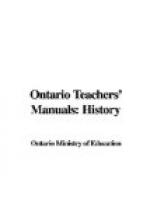There is great difference of opinion on the value of note-taking by pupils, but it may be said of such notes as those mentioned above that they have the advantage of being largely the pupil’s own work, especially when the pupils are asked to suggest the headings; they are a record of what has been decided in the class to be important points; they are arranged in the order in which the subject has been treated in the lesson, and are in every way superior to the small note-books in history that are sometimes used as aids or helps. For the proper teaching of history, the latter are hindrances rather than helps, because they rob the pupil of the profit gained by doing the work for himself. Notes obtained from books or dictated by the teacher are harmful to the right spirit of study, and create a distaste for the subject.
Special review lessons should be taken when a series of lessons on one topic, or on a series of connected topics, has been finished. At the close of each lesson, the facts learned are fixed more firmly in the mind by the usual drill; but there must be further organization of the several lessons by a proper review, so that history will not be a number of unconnected events, but will be seen as an orderly development. This may be accomplished: (1) by questioning the class from a point of view different from that taken in the first lessons, (2) by oral or written expansion of a topical outline, (3) by illustrations with maps or drawings, (4) by tracing the sequence of events backwards, (5) by submitting some new situation that will recall the old knowledge in a different way. It must be remembered that it is not a mere repetition that we seek, but a re-view of the facts, a new view that will prove the power of the pupils to use the knowledge they have gained. Thus the lesson on the St. Lawrence River (p. 112) is a good review of the facts of history suggested by the places mentioned; the lesson on the Road to Cathay (p. 92) may be considered a review of the chief explorers of North America. Such a review aims at seeing new relations, at connecting new knowledge and old, at “giving freshness and vividness to knowledge that may be somewhat faded, at throwing a number of discrete facts into a bird’s-eye view.”
THE USE OF PROBLEMS IN TEACHING HISTORY
The development, or problem, method is intended to get the pupils to do some independent thinking, instead of merely absorbing knowledge from the teacher. The plan is simply to set clearly before the pupils the conditions existing at a certain moment in the story so that they may see for themselves the difficulties that the people in the story had to overcome. The question for the class is: “What would you do in the circumstances?”
Let us take an example from the life of Ulysses. Ulysses had heard of the Sirens, who sang so beautifully that any one in a passing ship who heard them was impelled to throw himself overboard, with a frantic desire to swim to their island. Naturally the swimmers were all drowned in the attempt. Ulysses desired to hear for himself the wonderful singing, and to experience, perhaps, its terrible effect; but he certainly did not want to run any risk of drowning. Now, how did he accomplish his desire, without paying the penalty?




